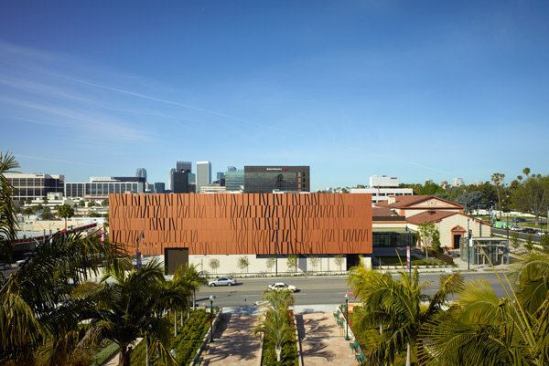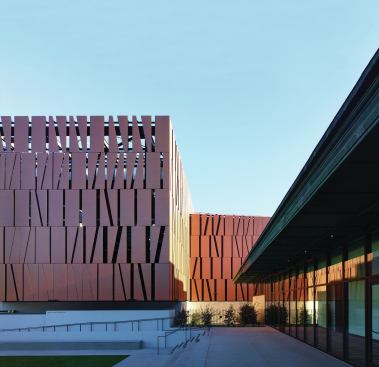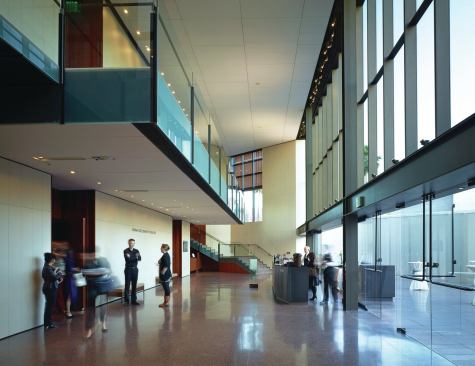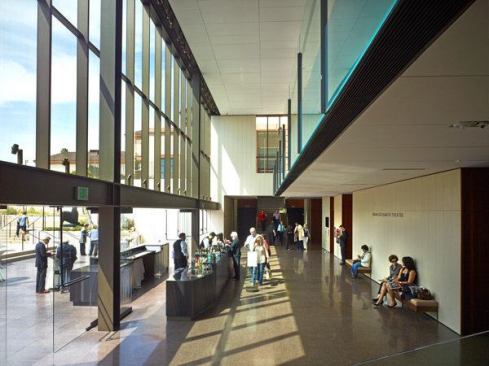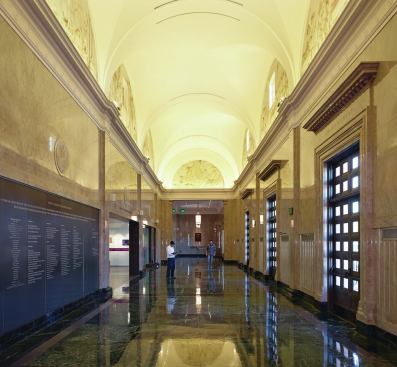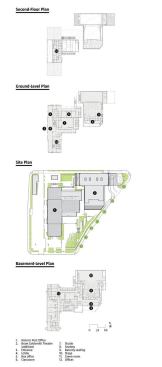Project Description
Before Beverly Hills, Calif., could become what it is today—alternately
the celebrated pinnacle of luxury or the denigrated epicenter of
moneyed excess—it had the modest needs of any young city. Between its
incorporation in 1914 and the late 1920s, the city had grown from 500
residents to more than 15,000, and locals decided they needed the basic
staples of citydom: a city hall and a post office.
City Hall, designed by architects Harry G. Koerner and William J. Gage
in the Spanish Renaissance style with a grand arched entryway and an
ornately tiled dome, was completed in 1932, and became an instant
landmark for Beverly Hills. When it opened, the Los Angeles Times
noted that it was “the largest and most costly City Hall of any
municipality its size in the country.” Two years later, architect Ralph
C. Flewelling matched City Hall’s extravagance with a new post office in
the Italian Renaissance style just across the street. A barrel-vaulted
ceiling runs the lobby’s length, its walls lined in marble with
ornamental plaster cornices.
These were elaborate projects for a country in the throes of the Great
Depression. They foreshadowed the ostentation to come in Beverly Hills,
but they were also an admission that even a city full of movie stars
needed a civic center to house its public services. These public
buildings validated Beverly Hills as a legitimate city.
And so it’s fitting that nearly a century later Beverly Hills is once
again turning to its civic center to validate its identity. This time,
the city is using the newly renovated and redesigned Beverly Hills Main
Post Office to rebrand itself less as a center of consumption, and more
as a center for culture, able to compete with the rest of Los Angeles.
In October 2013, after lying vacant for 16 years, the post office reopened as the Wallis Annenberg Center for the Performing Arts,
better known as the Wallis. With a 500-seat theater, a 120-seat studio
theater, and all the backstage requisites, the center is spacious enough
to host the cast and crew of a big show but intimate enough to put the
audience up close.
Instead of following the initial design brief and packing it all into
the original post office building, Culver City, Calif.–based Studio Pali Fekete Architects
(SPF:a) and its lead designer, Zoltan Pali, FAIA, added a new building
to house the main theater. A back area of the old post office is now a
walkway leading to a staircase that ducks below grade into the lobby of
the newly added theater building. The subterranean connection is not
evident from the outside, creating the impression that the
interconnected buildings are completely separate structures.
Walking around the site on an unusually hot spring day, Pali ducks into
the shade to point out the interplay between the two buildings, each
T-shaped and perpendicular to the other, like Tetris blocks about to
interlock. “That’s a part of the project I really like a lot, the part
where the two different buildings almost touch,” Pali says. “It’s like
walking through an old European city, like Genoa. You’re winding through
alleyways with multiple different architectural styles.”
Pali says it was important to reflect the cultural history of the site,
not necessarily its architectural history. In contrast to the old
office, his addition is unabashedly modern, with a striking copper-toned
façade of cement board panels shaped and spaced to suggest hundreds of
opened envelopes. The color changes with the sun, but it continues to
pair well with the terra-cotta of the historic post office and the
oxidized copper overhang above the old loading docks. Now, instead of
hosting idling trucks, that space is filled with glass-fronted
classrooms that bounce reflections of the modern addition, superimposing
the new on the old.
Zigzagging through the miniature alley, the site opens up to a terraced
sculpture garden leading down to a patio outside the theater’s lobby.
Inside, shades typically cover the floor-to-ceiling west-facing windows
during daylight hours to prevent glare. The theater space itself seems
deep for its modest size, and manages to fit in 350 seats (and a
soundproof “crying room”) on the ground floor and another 150 in a
balcony.
While the new building is certainly a highlight, the historic post
office remains an important part of the $70 million project. Its main
hall, once frequented by locals to buy stamps, now serves as a ticket
counter and grand entrance, with its restored vaulted ceiling and
original frescoes.
“Everyone was happy with that because the post office is really where
the energy was,” says Lou Moore, executive director of the Wallis. “That
was the impetus from the beginning, to save the post office and bring
it back to life for the whole community.”
“I remember standing out there on opening night. It felt like someone
took a little handful of culture dust and ‘Poof!’ It felt like, ‘Wow,
there’s culture here now,’ ” Pali says. “Even though there’s people with
a tremendous amount of money and art, it never really felt like there
was a place in Beverly Hills that was striving for the highest
aspirations of culture.”
When the post office was decommissioned in the late 1990s, the city was
quick to buy the building, and, even then, city leaders already had a
cultural center in mind. With the opening of the Wallis, the city has
finally gotten what it wanted. —Nate Berg

